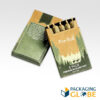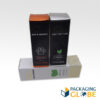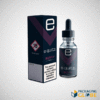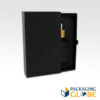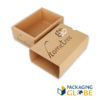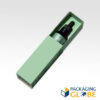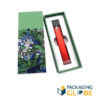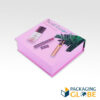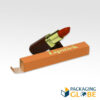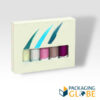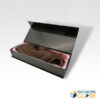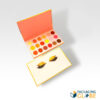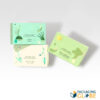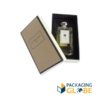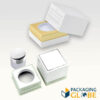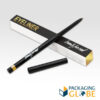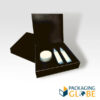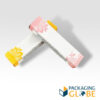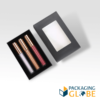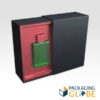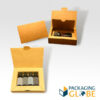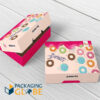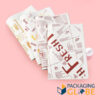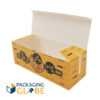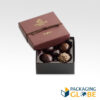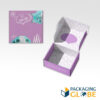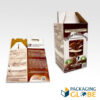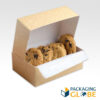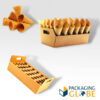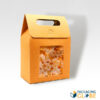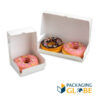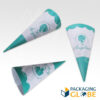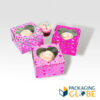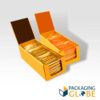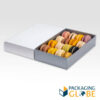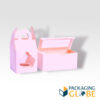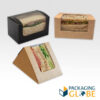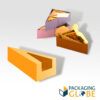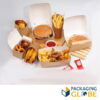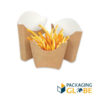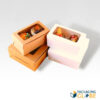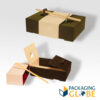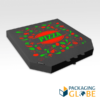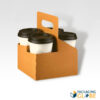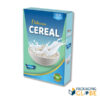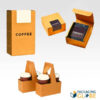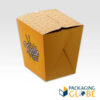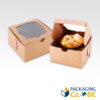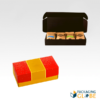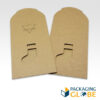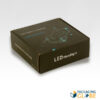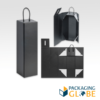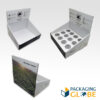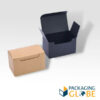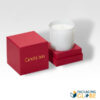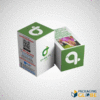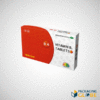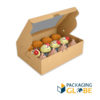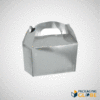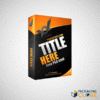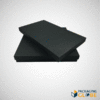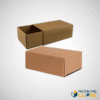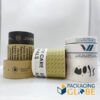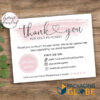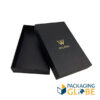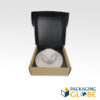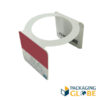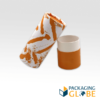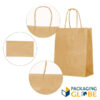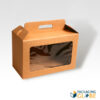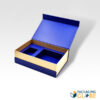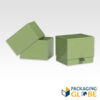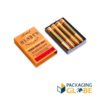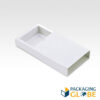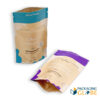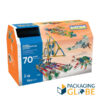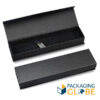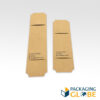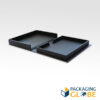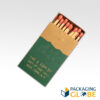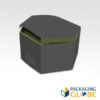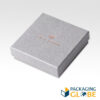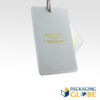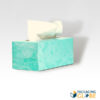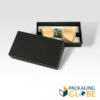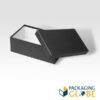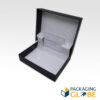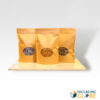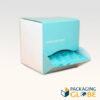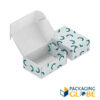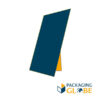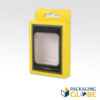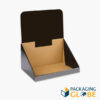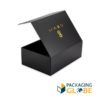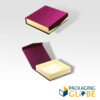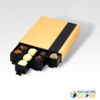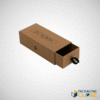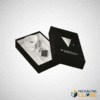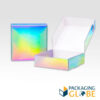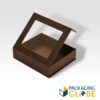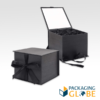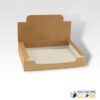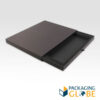FAQs
Packaging boxes are essential for order completion time for several crucial reasons:
1. Product Protection: Packaging boxes are designed to safeguard products during transit and storage. They shield items from physical damage, moisture, dust, and potential contamination. Without adequate protection, products are at risk of being damaged or spoiled, leading to costly replacements, delays, and customer dissatisfaction.
2. Efficient Handling: Properly packaged items are easier to handle, sort, and transport. They can be stacked, palletized, and moved with greater efficiency, reducing the risk of delays in the supply chain. Efficient handling minimizes the likelihood of errors, such as misplacements or damage during loading and unloading.
3. Brand Image: Packaging is a direct reflection of a brand’s professionalism and commitment to quality. Well-designed packaging not only protects the product but also enhances its presentation. This positively impacts the customer’s perception of the brand and can lead to repeat business and positive reviews.
4. Compliance and Documentation: In some industries, regulations require specific packaging and labelling for compliance. Failure to adhere to these requirements can lead to delays due to inspections, rejections, or legal issues. Proper packaging ensures compliance with local and international regulations.
5. Logistics and Inventory Management: Packaging boxes often include essential product information, barcodes, and tracking numbers. This information is crucial for logistics and inventory management systems, allowing for accurate tracking and efficient order fulfillment. Without it, the entire process can slow down.
6. Customer Experience: Timely and intact delivery is a vital part of the customer experience. Packaging boxes that protect products and arrive in good condition contribute to customer satisfaction and can lead to positive reviews, repeat orders, and referrals.
In essence, packaging boxes are not merely containers; they are integral to the smooth and efficient flow of goods through the supply chain. They help prevent delays, ensure product integrity, and enhance the overall customer experience, making them a critical component of order completion time and overall business success.
The shipping process in the UK, Europe, and the USA follows a generally similar framework, but specific details and regulations may vary by country and region. Here’s an overview of the shipping process in each of these regions:
United Kingdom (UK):
1- Order Placement: The process typically begins when a customer places an order with a retailer or online store.
2- Order Processing: The retailer processes the order, including picking and packaging the items.
3- Labeling and Documentation: The retailer generates shipping labels and prepares the necessary shipping documentation, including customs declarations if applicable.
4- Carrier Selection: The retailer or e-commerce platform selects a carrier or courier service for shipping. Popular carriers in the UK include Royal Mail, DPD, Hermes, and UPS.
5- Collection: The carrier collects the packages from the retailer’s location or warehouse.
6- Transportation: The carrier transports the packages to a local sorting facility or distribution centre.
7- Sorting and Routing: Packages are sorted based on their destination, and routing is determined to ensure efficient delivery.
8- Delivery: The packages are delivered to the recipient’s address. In some cases, additional customs clearance may be required for international shipments.
9- Confirmation: The recipient receives the package, and the carrier often provides tracking information and delivery confirmation.
Europe:
The shipping process in Europe is similar to the UK, but it involves cross-border shipments and may include additional customs procedures for deliveries between European Union (EU) member countries and non-EU countries.
United States (USA):
1- Order Placement: Customers in the USA place orders with retailers or e-commerce platforms.
2- Order Processing: Retailers process orders, pick products, and prepare packages for shipping.
3- Labeling and Documentation: Shipping labels and relevant documentation are generated, including customs forms for international shipments.
4- Carrier Selection: Retailers choose from a variety of carriers, such as USPS, UPS, FedEx, or regional carriers, depending on the service level and destination.
5- Collection: Carriers collect packages from the retailer’s facility.
6- Transportation: Packages are transported to regional or central hubs.
7- Sorting and Routing: Packages are sorted, and routing is determined for efficient delivery.
8- Delivery: Carriers deliver packages to the recipient’s address. In some cases, customs clearance may be required for international shipments.
9- Confirmation: Recipients receive packages and can track deliveries through provided tracking information.
It’s important to note that shipping times, fees, and regulations can vary widely depending on the specific carrier, shipping method, and destination. Customs procedures can also add complexity to international shipments. Businesses often work closely with shipping experts or use shipping management software to streamline the process and ensure compliance with regulations.
Corrugated cardboard boxes are not immune to the possibility of insect infestations, even when stored in a dry room. While a dry environment is generally less conducive to insect activity compared to damp or humid conditions, it’s essential to consider a few factors:
1- Previous Contamination: If the boxes were previously stored in a place where they were exposed to pests, they may already have eggs or larvae inside. These pests can become active when conditions become more favourable.
2- Access Points: Insects can find their way into cardboard boxes through small openings or gaps. If the boxes are stored near doors, windows, or other potential entry points for insects, this increases the risk of infestation.
3- External Sources: Insects can be introduced to the storage area from external sources, such as contaminated packaging materials, other stored items, or pests entering the room through openings.
4- Food Residues: If the boxes previously contained food items or were stored near food, they might have food residues or odours that attract insects.
To minimize the risk of insect infestation:
Inspect and Clean: Before storing items in cardboard boxes, inspect them for any signs of insects or damage. Ensure that the boxes themselves are clean.
Seal Openings: Seal any openings or gaps in the storage area that could serve as entry points for insects.
Use Pest Control Measures: Consider using pest control measures like traps, baits, or insecticides in the storage area to deter or eliminate pests.
Store Boxes Properly: Elevate cardboard boxes off the floor and away from walls to reduce the risk of pests accessing them.
While corrugated cardboard is less susceptible to insect infestations than materials like wood or cloth, taking preventative measures is wise to protect your stored items from potential contamination or damage.
You can find a product packaging designer for custom boxes through various channels, both online and offline. Here are some effective ways to locate a packaging designer:
- Online Freelance Platforms: Websites like Upwork, Freelancer, and Fiverr have numerous packaging designers who offer their services on a freelance basis. You can browse portfolios, review client feedback, and hire designers based on your specific requirements.
- Design Agencies: Many design agencies specialize in packaging design. Conduct an online search or ask for referrals to find agencies with experience in creating custom boxes.
- Social Media: Platforms like LinkedIn, Instagram, and Behance are used by many designers to showcase their work. You can explore profiles, and portfolios, and connect with designers who match your needs.
- Design Marketplaces: Websites such as 99designs and Designhill allow you to run design contests or directly hire designers for packaging projects. You set your budget, and designers submit their concepts.
- Industry Conferences and Events: Attend design-related conferences, trade shows, or networking events in your area. These events often attract packaging designers looking to connect with potential clients.
- Local Design Schools: Contact local design schools or universities with design programs. They may have talented students or recent graduates looking for freelance opportunities.
- Professional Organizations: Organizations like the American Institute of Graphic Arts (AIGA) or the Packaging Designers Council (PDC) often have directories of experienced designers.
- Recommendations and Referrals: Ask for recommendations from peers, colleagues, or business contacts who have worked with packaging designers in the past.
- Online Portfolio Websites: Explore portfolio websites like Behance, Dribble, or Coroflot, where designers showcase their work. You can search for packaging designers and contact them directly.
- Online Classifieds: Platforms like Craigslist or Gumtree may have local designers advertising their services.
When hiring a packaging designer, be sure to review their portfolio, discuss your project’s specific requirements and budget, and ask for references if needed. Effective communication and a clear understanding of your brand and product are key to achieving a successful custom packaging design.
Custom food packaging boxes often feature various coatings and finishes to enhance their appearance, durability, and functionality. Here are some common types of coatings used for food packaging boxes:
1- Gloss Coating: Gloss coating adds a shiny and reflective finish to the packaging, giving it a polished and attractive look. It also provides some protection against moisture and wear.
2- Matte Coating: Matte coating gives the packaging a non-glossy, elegant, and soft finish. It reduces glare and can lend a more sophisticated feel to the packaging.
3- Aqueous Coating: Aqueous coating is a water-based coating that provides a protective layer to prevent scuffing, fingerprints, and moisture damage. It can be either gloss or matte and is more environmentally friendly than some other coatings.
4- UV Coating: UV coating involves the use of ultraviolet light to cure and harden the coating quickly. It offers a high-gloss finish, and excellent protection, and can make colours appear more vibrant.
5- Varnish: Varnish is a transparent coating that adds a layer of protection and can enhance the appearance of printed designs. It can be glossy or matte, and spot varnish can be applied selectively to create visual effects.
6- Embossing and Debossing: These processes involve creating raised (embossing) or recessed (debossing) patterns or text on the packaging’s surface. They add texture and visual appeal.
7- Foil Stamping: Foil stamping uses metallic foil to create shiny, reflective elements on the packaging. It’s often used for branding and decorative purposes.
8- Soft-Touch Coating: Soft-touch coating gives the packaging a velvety, tactile feel that can enhance the perceived quality of the product.
9- Anti-Scuff Coating: This coating is designed to prevent scuffing, rubbing, and abrasion during handling and transit, ensuring the packaging maintains its pristine appearance.
10- Grease-Resistant Coating: Commonly used for food packaging, grease-resistant coatings repel oils and liquids, keeping the packaging clean and preventing sogginess or staining.
11- Window Patching: This involves adding a transparent window to the packaging, usually covered with a clear plastic film, allowing consumers to see the product inside.
The choice of coating depends on several factors, including the type of food, the packaging material, branding requirements, and the desired visual and tactile effects. Food safety regulations and environmental considerations should also be taken into account when selecting coatings for custom food packaging boxes.
Finding the latest box design templates for your new custom products can be done through various sources, both online and offline. Here are some effective ways to locate box design templates:
1- Graphic Design Software: Popular design software like Adobe Illustrator, Adobe Photoshop, and CorelDRAW often have a range of pre-made templates for various packaging types, including boxes. Check the template libraries within these programs.
2- Online Template Marketplaces: There are websites that specialize in offering a wide variety of design templates, including box templates. Some popular ones include GraphicRiver, Creative Market, and Template.net. You can purchase and download templates that match your product’s needs.
3- Printing Companies: Many printing companies and packaging suppliers offer design templates for their specific products. Check with the company you plan to use for printing your custom boxes, as they might provide templates for your custom specifications.
4- Online Design Tools: Some online design tools and packaging customization platforms offer access to design templates. These platforms allow you to design your packaging online, often starting with a template and customizing it to your needs.
5- Graphic Design Communities: Online communities like Behance, Dribble, and Pinterest are great places to discover unique packaging designs. You might find designers who share their templates or are inspired by existing packaging designs.
6- Design Books and Magazines: Design books and magazines often feature packaging design examples and may include templates or design ideas that you can adapt for your custom packaging.
7- Design Agencies: If you’re working with a design agency or freelancer, they should be able to create custom packaging templates tailored to your product.
8- DIY Packaging Tools: Some packaging companies offer online tools that allow you to design your custom packaging using their templates and interfaces. You can often find these on the websites of packaging manufacturers.
When using templates, it’s important to ensure that they match your specific box dimensions and printing requirements. Customizing existing templates to fit your brand and product is common and can save time in the design process. However, if you have unique or complex packaging needs, consider working with a professional graphic designer or packaging specialist to create a custom template from scratch.
3D printing offers several benefits to the packaging industry, making it a valuable technology for various applications. Here are some of the advantages of using 3D printing in packaging:
- Customization: 3D printing allows for highly customizable packaging solutions. Brands can create unique and personalized packaging designs to differentiate their products in the market. This is particularly beneficial for luxury or niche products that require a distinct identity.
- Prototyping: 3D printing enables rapid prototyping of packaging concepts. Designers and manufacturers can quickly create physical prototypes to test and refine packaging designs, reducing the time and cost associated with traditional prototyping methods.
- Complex Geometries: 3D printing can produce packaging with intricate and complex shapes that would be difficult or impossible to achieve with traditional manufacturing methods. This opens up new design possibilities for packaging that can enhance product presentation and functionality.
- Reduced Material Waste: Traditional manufacturing processes often generate significant material waste, especially when producing complex shapes. 3D printing is an additive manufacturing method, meaning it adds material layer by layer, resulting in minimal waste and efficient use of resources.
- Short Production Runs: 3D printing is well-suited for small-batch or on-demand production. This flexibility is valuable for seasonal packaging designs, limited-edition products, or niche markets where traditional mass production may not be cost-effective.
- Lightweighting: 3D printing allows for the creation of lightweight yet durable packaging. This is important for reducing shipping costs, minimizing environmental impact, and meeting sustainability goals.
- Innovative Features: 3D printing can integrate functional features into packaging, such as snap-fit closures, hinges, and compartments. This can enhance user experience and product functionality.
- Brand Engagement: Unique 3D-printed packaging can engage customers and create a memorable unboxing experience. Brands can leverage the tactile and visual appeal of 3D-printed packaging to leave a lasting impression.
- Reduced Tooling Costs: Unlike traditional manufacturing, which often requires expensive molds and tooling, 3D printing doesn’t have high upfront tooling costs. This makes it more accessible for small and medium-sized businesses.
- Speed to Market: 3D printing can accelerate product development and time to market. Design iterations and changes can be implemented quickly, allowing brands to respond rapidly to market trends and consumer preferences.
- Material Variety: 3D printing supports a wide range of materials, including plastics, metals, ceramics, and even food-grade materials. This versatility allows for packaging solutions tailored to specific product requirements.
- Sustainability: By reducing material waste, offering lightweight designs, and enabling on-demand production, 3D printing aligns with sustainability goals and can contribute to more eco-friendly packaging practices.
While 3D printing offers numerous advantages, it’s essential to consider factors like material selection, production costs, and scalability when implementing this technology in the packaging industry. As 3D printing continues to advance, it is likely to play an increasingly significant role in packaging design and production.
The number of units you can produce per day with a 3D printer for custom packaging boxes depends on several factors, including the complexity of the design, the size of the boxes, the type of 3D printer, and the printing speed. Here are some key considerations:
1- Print Speed: The speed at which your 3D printer operates can vary significantly. Some consumer-grade 3D printers may have relatively slow print speeds, while industrial-grade printers can be much faster. The faster the printer, the more units you can produce in a given time frame.
2- Box Size and Complexity: Smaller and less complex boxes will typically take less time to print than larger, intricate designs. Consider the size and complexity of your custom packaging when estimating production rates.
3- Printer Efficiency: The efficiency and reliability of your 3D printer play a crucial role. High-quality, well-maintained printers are less likely to experience downtime or printing errors, allowing for continuous production.
4- Layer Height and Resolution: The layer height and resolution settings you choose can impact print time. Finer layers and higher resolutions generally result in longer print times but may be necessary for intricate designs.
5- Print Material: The type of material you use for 3D printing can affect production rates. Some materials may require slower print speeds or additional post-processing steps.
6- Print Queue Management: Efficiently managing your print queue can help maximize production. This involves scheduling and optimizing print jobs to minimize downtime between batches.
7- Post-Processing: After printing, there may be post-processing steps such as cleaning, assembly, or finishing. These steps can add to the overall production time.
8- Scaling: If you have multiple 3D printers working simultaneously, you can increase your daily production capacity.
To provide a rough estimate, a typical consumer-grade 3D printer may produce a few custom packaging boxes per day, while an industrial-grade printer could produce dozens or even hundreds, depending on the factors mentioned above. It’s important to conduct tests and calculations based on your specific printer and project requirements to determine your daily production capacity accurately.
Keep in mind that 3D printing is often best suited for prototyping, small-batch production, and highly customized designs. For large-scale production of packaging boxes, traditional manufacturing methods like die-cutting and offset printing are generally more efficient and cost-effective.

